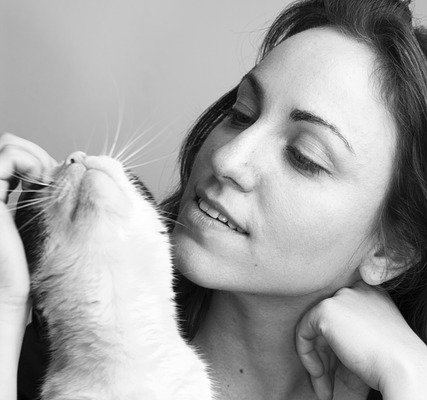Our fabulous feline’s use a variety of interesting ways to communicate with their human caregivers including a combination of body language, facial expressions and vocalisation. Having a stronger understanding of these complex behaviours can help you communicate better with your cat and strengthen the bond with your feline friend!
Purring
One of the most obvious and recognisable vocalisations; purring usually indicates contentment but be aware that some cats can purr when they feel scared or sick, as a method of self-soothing. Some cats purr loudly some cats are quieter, have a listen to your cat’s purr next time they are content to really tune in to the happy sounds!
Rubbing against you
When your cat rubs up against you - whether this be on your legs or face etc., it’s their way of ‘marking’ what is theirs for familiarity. When they rub their face, cheeks or body against you, they transfer their scent on to you as a way of ‘claiming ownership’ of you and is a mark of affection.
Meowing
Did you know that cats generally only meow to humans, and rarely to other cats? Meowing is often used for getting their human slaves’ attention - be that a greeting, approval or demanding food! Very young kittens will meow to get their mother’s attention, but as they get older it’s rare for adult cats to meow at each other. You can encourage your cat to talk to you and ‘converse’ by responding to their sounds. After a while you will get to know your cat’s meows and understand which sound is for food and which is for attention, although in some cases you could say this is one and the same!
A short meow is like a standard greeting or ‘hello’. A drawn-out meow can be a demand for something immediately like ‘feed me now’ or ‘open the door’. A higher pitched longer meow, or yowl could mean pain or anger. This could be if another cat is in their territory; e.g. ‘I don’t want you here!’ or ‘leave me alone’ but can also be a sign that they are feeling unwell. So, if he or she is unusually vocal, please do check for any signs of illness and consider bringing them in to us for a health check.
Kneading
Kneading is a sign that your cat is relaxed and happy. Sometimes it’s not so pleasant for us, especially if they choose your lap, but this behaviour is extremely soothing for them! It usually involves them paddling or kneading their paws into their chosen surface; a blanket or bed etc. This is thought to start when they are tiny kittens, as the kneading movement helps stimulate milk release when they are suckling from their mother.
Body language
The way a cat is holding their tail gives us a lot of information about how they are feeling. When a cat holds their tail high, this can often indicate confidence. When they wrap it around their human’s leg or another cat’s tail this suggests friendliness and acceptance. If their tail is tucked between their legs this means they are feeling anxious or insecure. A fast-moving high swishy tail indicates that your cat isn’t happy at all and want to be left alone as they are feeling threatened - particularly if this is combined with an arched back and holding their ears back - this could be a signal that they may lash out. A hunched, rigid, tense posture could also indicate a sign of pain.
Blinking slowly
In cat-speak, closing one’s eyes slowly in the presence of another is a sign of trust - so by blinking slowly at your cat, you are letting them know that you pose no threat. Have you tried this one?
Hissing
Most cat parents would have heard their cat hiss at some point. Hissing is a warning - an indication that they are feeling threatened or frightened by something in their immediate surrounding. This may be another cat, owner, or vet(!) This defensive vocalisation is a warning that you should back off, or aggression will follow - this will be a scratch or bite. Give the cat time to calm down and provide an avenue of escape if possible and let her get used to your scent before you try to touch her.
It’s useful to be aware of the triggers that cause her to feel threatened - perhaps. if you are introducing two cats to each other, this should be done in a very careful, supervised and gradual manner to minimize stress and threats over territory and resource. If your cat hisses repeatedly when you try to handle or interact with her then this could be another sign of pain or discomfort and you should get her seen by one of our experienced feline vets for a checkup.
Worried about your cat? Not sure what he or she is trying to tell you? Give us a ring, we have a whole team of expert cat lovers and interpreters here to help!


